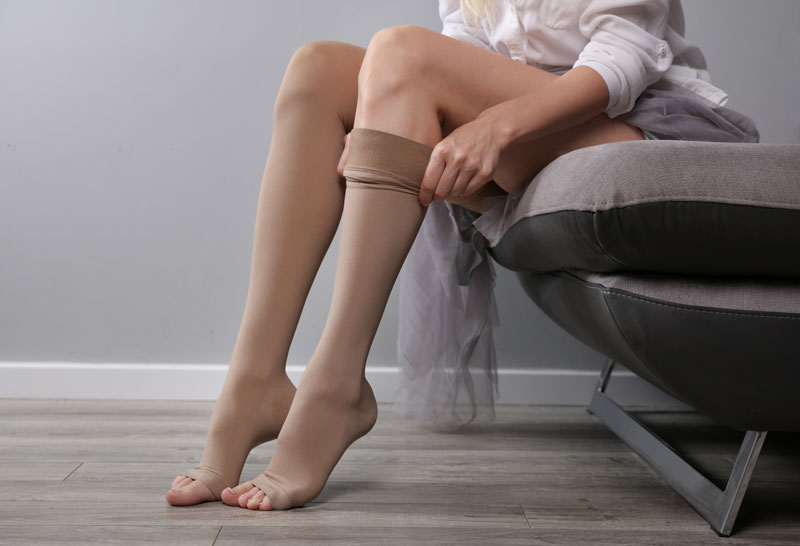The elastic compression garments manufactured to be worn around the legs that compress the limb area are known as compression socks or stockings. These are also called circulation socks as they help to improve the blood circulation of the leg portion.
Circulation socks are primarily designed for comforting leg related issues such as
Edema, venous disorders, thrombosis and phlebitis.
Table of Contents
How they are Made
Circulation socks are manufactured by using materials such as rubber or elastic fibres. These fibres help in compressing the limb, which betters the circulation.
Compression socks or stockings are embedded with different levels of compression. The unit of measurement of pressure applied by the circulation socks is mmHg.
Working of Compression Socks
What are compression socks and how they work is the usual question that arises in people’s minds when they first hear about these socks. So, here is the detailed information about the working of the socks.
The compression begins with a light squeeze/pressure, at the foot. The tightest compression occurs at the ankle, followed by a reduced, cumulative and carefully assessed squeeze shifting up the leg. This compression secures blood flows toward the heart instead of going down toward the feet or even flows laterally into the superficial veins. This upward movement of blood flow keeps blood from concentrating in the ankles, yielding it to the heart and lungs far more efficiently than without using compression socks.
Compression lessens the diameter of primary veins, which boosts the volume and velocity of blood flow.
The overall pressure felt due to the compression is influenced by many factors, including the stiffness and elasticity of the compression fabric, the shape and size of our legs, our movements and leg activities. As a result, improved blood oxygen levels are experienced, enhancing the athletic performances, speed-up muscle recovery, and leaving our legs feeling relaxed and energized.
Why we need them?
“Why wear compression socks?”, has been a question among people since the invention of these socks. After understanding the purpose and benefits of the compression socks, people agree that compression socks are boon. They do make our legs feel reenergized and active, compression feels like a mini-massage for our legs.
Compression socks have more benefits than just making our legs feel amazing. They lessen the leg pains and cramping and reduce swelling in the ankles and feet. Using compression socks can also help maintain our legs’ health; it happens to help delay the onset of varicose veins. Importantly, they help prevent a deep vein thrombosis, a life-threatening blood clot that may appear in the legs.
Usefulness
Athletes
Elite and amateur athletes use compression socks to enhance their athletic performance, speed up muscle recovery and ease the lactic acid build-up that arises post-workout. Lactic acid can leave your legs feeling exhausted. One can wear the compression socks made from microfibers and the one made with sheer texture under winter running gear as they are flexible.
Travellers
Aged travellers wear compression socks to relieve leg cramps and swollen feet and reduce their risk of developing a DVT on a long flight.
Healthcare Workers
The healthcare workers acknowledge the benefits of using compression socks from their medical education and operating with patients. The compression socks are part of their medical uniform, for their 10-12 hour long shifts where they are needed to perform continuous physical activities.
Pregnant Women
Circulation hosiery helps to soothe the muscles, which result in blood flow to move upward towards the rest of the body. It enhances circulation throughout the body and reduces swelling, vein thrombosis, DVT etc., which are the concerns during the pregnancy.

How to wear Compression Socks
Smooth out the socks to prevent bunching so that they can lie flat against your skin.
Make sure they are not too lengthy. Don’t fold the fabric, because that can make them extremely tight. It could cause blood flow issues or cut off your circulation.
If your doctor has advised you to wear them, you will probably keep them on for most of the time. Take them off before shower or bath. You can wear other socks, footwear over compression stockings. Consult with your doctor on how often and how long you could use them.
Maintenance of Compression Socks
Wash the stockings or socks after taking them off at the end of the day.
For hygienic reasons, so that there’s no occurrence of odour and bacteria on the fabric. Also, to ensure that the material stays effective, the socks recoup their original elasticity and compression after being washed.
Wash your compression hosiery in the washing machine at a temperature of 30 or 40 degrees. Wash them gently. Use normal detergent without brightness colours. Make sure not to use fabric softeners. Spin the sock at a maximum of 1,200 revolutions per minute.
Conclusion
We saw that compression socks are useful for medical purposes as well as other additional benefits too. Manufacture and working of these socks are innovative and impressive. We can assume that compression socks will make their place in many lives who need its benefits.
Circulation hosiery helps to soothe the muscles, which result in blood flow to move upward towards the rest of the body. It enhances circulation throughout the body and helps to lessen swelling, vein thrombosis, DVT etc.










